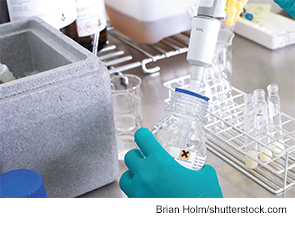
BOSTON—Speakers at the ACR/ARHP Annual Meeting in Boston in November 2014 highlighted proteomic and metabolomic research during a session called Advances in Molecular Profiling and Relevance to Autoimmune Disease. Advances in the research point to a role for proteomic-based profiling in rheumatologic diseases for biomarker development and help clarify a relationship of metabolomics with autoimmune and rheumatic disease.
William H. Robinson, MD, PhD, associate professor of medicine, immunology and rheumatology at Stanford School of Medicine, outlined translational research efforts to identify molecular signatures of disease subtypes that could give rise to next-generation biomarkers to guide clinical decision making. The research is using “composite signaling profiles to identify pathogenic mechanisms in RA,” Dr. Robinson said.
Genomics & proteomics can tell you what might happen, but metabolomics tells you what actually did happen.
Research has shown that RA-related autoantibodies develop years prior to clinical onset of RA, but the initial antigen targets and how these antibodies develop are not well understood. In studies conducted by Dr. Robinson and colleagues, researchers found that autoantibodies target several innate immune ligands at early time points before clinical RA develops.1 The targeted ligands include citrullinated histones, fibrinogen, and biglycan. Expansion of the anticitrullinated protein antibody (ACPA) predicted elevations in inflammatory cytokines, including TNF-α, IL-6, IL-12p70 and IFN-γ. Their findings indicate that the preclinical phase of RA is characterized by an accumulation of multiple autoantibody specificities reflecting the process of epitope spread. This epitope spread is also correlated with development of preclinical inflammation, thus providing a biomarker profile that could predict imminent onset of clinical arthritis, he said.
Role of Citrullinated Proteins
Research by Drs. Robinson, Jeremy Sokolove and colleagues published in 2013 showed that citrullinated proteins are present within atherosclerotic plaque and that RA-associated autoantibodies can target the protein in atherosclerotic plaque tissue.2 Those findings provided a foundation for future studies investigating the role of ACPA as a contributor to the accelerated atherosclerosis observed in patients with RA.
The production of autoantibodies, including ACPAs, is a defining factor in RA, but targets of these antibodies are not clearly defined. B cells that are specific for the inciting antigens are activated during an immune response and differentiate into plasmablasts that are released into the blood. Dr. Robinson and colleagues3 published research in 2014 that described efforts to sequence the plasmablast antibody repertoire to define the targets of active immune response in RA. Using a novel DNA barcoding method, they showed that autoantibodies targeting α-enolase, citrullinated fibrinogen and citrullinated histone H2B are produced by ongoing activated B cell response in RA and may contribute to the pathogenesis of RA, Dr. Robinson said.

